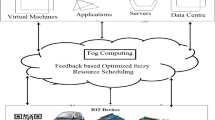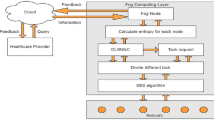Abstract
The exponential expansion in the number of smart devices in the burgeoning Internet of Things (IoT) is driving the growing demand for effective storage techniques. Cloud computing has shown to be an excellent alternative for storing and processing enormous amounts of data thus far. Cloud computing, on the other hand, is predicted to be unable to successfully handle a significant number of IoT devices in the coming years due to bandwidth constraints. Fog computing is a novel technology that is supposed to solve many of the problems associated with large-scale networks on the Internet of Things. Fog computing brings high-quality cloud services closer to mobile users. To overcome all the existing drawbacks, this study improves QoS using fog computing based on Sigmoid Neural Network Clustering (SNNC) and Entropy-Based Scheduling (EBS). The work of the IoT sensors is to collect all the data and send them to the fog computing tier. After that, fog computing performs score value calculation for each fog node based on SNNC as well as EBS. Here, the data and information collected by the edge devices are analyzed in this tier. Cloud Computing manages the various actions that are to be performed by the system. A component of the monitoring runs on the sensors which enable the sensors to collect data and send it to the fog layer also the cloud computing tier constantly supervises the system. The experimental results QoS show that our proposed strategy outperforms the traditional method.














Similar content being viewed by others
Data availability
Not applicable.
References
Aazam M, Zeadally S, Harras KA (2018) Fog computing architecture, evaluation, and future research directions. IEEE Commun Mag 56(5):46–52
Albouq SS, Sen AAA, Namoun A, Bahbouh NM, Alkhodre AB, Alshanqiti A (2020) A double obfuscation approach for protecting the privacy of IoT location based applications. IEEE Access 8:129415–129431
Anawar MR, Wang S, Zia MA, Jadoon AK, Akram U, Raza S (2018) Fog computing: An overview of big IoT data analytics. Wirel Commun Mob Comput 2018
Badawy MM, Ali ZH, Ali HA (2019) Qos provisioning framework for service-oriented internet of things (iot). Clust Comput:1–17
Brogi A, Forti S (2017) QoS-aware deployment of IoT applications through the fog. IEEE Internet Things J 4(5):1185–1192
Byers CC (2017) Architectural imperatives for fog computing: Use cases, requirements, and architectural techniques for fog-enabled iot networks. IEEE Commun Mag 55(8):14–20
Chen H, Wang FZ (2015) Spark on entropy: A reliable & efficient scheduler for low-latency parallel jobs in heterogeneous cloud.In: 2015 IEEE 40th Local Computer Networks Conference Workshops (LCN Workshops), pp. 708–713, IEEE
Deepa N, Pandiaraja P (2020) E health care data privacy preserving efficient file retrieval from the cloud service provider using attribute based file encryption. J Ambient Intell Humaniz Comput:1–11
Dutton LM, d'Alves C, Kahl W, Enenkel RF, Anand CK (2020) Designing and evaluating new instructions that accelerate sigmoid-based machine learning. In Proceedings of the 30th Annual International Conference on Computer Science and Software Engineering (pp. 189–197)
Ghobaei-Arani M, Shahidinejad A (2022) A cost-efficient IoT service placement approach using whale optimization algorithm in fog computing environment. Expert Syst Appl 15(200):117012
Goudarzi M, Huaming W, Palaniswami MS, Buyya R (2020) An application placement technique for concurrent IoT applications in edge and fog computing environments. IEEE Trans Mob Comput
Habibi P, Farhoudi M, Kazemian S, Khorsandi S, Leon-Garcia A (2020) Fog computing: a comprehensive architectural survey. IEEE Access 8:69105–69133
Hassen HB, Dghais W, Hamdi B (2019) An E-health system for monitoring elderly health based on Internet of Things and Fog computing. Health information science and systems 7(1):1–9
Hussein MK, Mousa MH (2020) Efficient task offloading for iot-based applications in fog computing using ant colony optimization. IEEE Access 8:37191–37201
Jaiswal K, Anand V (2019) EOMR: An energy-efficient optimal multi-path routing protocol to improve QoS in wireless sensor network for IoT applications. Wirel Pers Commun:1–23
Jamil B, Shojafar M, Ahmed I, Ullah A, Munir K, Ijaz H (2020) A job scheduling algorithm for delay and performance optimization in fog computing. Concurr Comput: Pract Exp 32(7):e5581
Lera I, Guerrero C, Juiz C (2018) Availability-aware service placement policy in fog computing based on graph partitions. IEEE Internet Things J 6(2):3641–3651
Liu C, Wang J, Zhou L, Rezaeipanah A (2022 Jun) Solving the multi-objective problem of IoT service placement in fog computing using cuckoo search algorithm. Neural Process Lett 54(3):1823–1854
Luo J, Yin L, Jinyu H, Wang C, Liu X, Fan X, Luo H (2019) Container-based fog computing architecture and energy-balancing scheduling algorithm for energy IoT. Futur Gener Comput Syst 97:50–60
Mahmud R, Srirama SN, Ramamohanarao K, Buyya R (2019) Quality of Service (QoS)-aware placement of applications in Fog computing environments. J Paral Distrib Comput 132:190–203
Mao H, Schwarzkopf M, Venkatakrishnan SB, Meng Z, Alizadeh M (2019) Learning scheduling algorithms for data processing clusters. In: Proceedings of the ACM special interest group on data communication Aug 19 (pp. 270–288)
Misra S, Saha N (2019) Detour: Dynamic task offloading in software-defined fog for IoT applications. IEEE J Sel Areas Commun 37(5):1159–1166
Naha RK, Garg S, Georgakopoulos D, Jayaraman PP, Gao L, Xiang Y, Ranjan R (2018) Fog computing: Survey of trends, architectures, requirements, and research directions. IEEE Access 6:47980–48009
Nashaat H, Ahmed E, Rizk R (2020) IoT application placement algorithm based on multi-dimensional QoS prioritization model in fog computing environment. IEEE Access 8:111253–111264
Nguyen ND, Phan L-A, Park D-H, Kim S, Kim T (2020) ElasticFog: Elastic Resource Provisioning in Container-Based Fog Computing. IEEE Access 8:183879–183890
Nguyen H, Drebenstedt C, Bui XN, Bui DT (2020 Apr) Prediction of blast-induced ground vibration in an open-pit mine by a novel hybrid model based on clustering and artificial neural network. Nat Resour Res 29(2):691–709
Ni J, Zhang K, Lin X, Shen X (2017) Securing fog computing for internet of things applications: Challenges and solutions. IEEE Commun SurvTutor 20(1):601–628
Omoniwa B, Hussain R, Javed MA, Bouk SH, Malik SA (2018) Fog/edge computing-based IoT (FECIoT): Architecture, applications, and research issues. IEEE Int Things J 6(3):4118–4149
Ramprasad B, Mukherjee J, Litoiu J (2018) A smart testing framework for iot applications. In: In 2018 IEEE/ACM International Conference on Utility and Cloud Computing Companion (UCC Companion). IEEE, pp 252–257
Santos-Sales A, Casotti CA (2019) Reclassification of the Framingham risk score and its agreement with other three calculations. Aquichan.;19(2).
Tordera EM, Masip-Bruin X, Garcia-Alminana J, Jukan A, Ren GJ, Zhu J, Farré J (2016) What is a fog node a tutorial on current concepts towards a common definition. arXiv preprint arXiv:1611.09193
Verma P, Sood SK (2018) Fog assisted-IoT enabled patient health monitoring in smart homes. IEEE Internet Things J 5(3):1789–1796
Vilela PH, Rodrigues JJPC, Solic P, Saleem K, Furtado V (2019) Performance evaluation of a Fog-assisted IoT solution for e-Health applications. Futur Gener Comput Syst 97:379–386
Wanto A, Windarto AP, Hartama D, Parlina I (2017) Use of binary sigmoid function and linear identity in artificial neural networks for forecasting population density. IJISTECH (Int J Inform SystTechnol) 1(1):43–54
Yan H, Wang L, Lu Y (2019 Feb) Identifying cluster centroids from decision graph automatically using a statistical outlier detection method. Neurocomputing. 15(329):348–358
Yang W, Li W, Cao Y, Luo Y, He L (2020) Real-Time Production and Logistics Self-Adaption Scheduling Based on Information Entropy Theory. Sensors 20(16):4507
Zhang H, Xie J, Ge J, Lu W, Zong B (2018) An entropy-based PSO for DAR task scheduling problem. Appl Soft Comput 1(73):862–873
Funding
In this research article has not been funded by anyone.
Author information
Authors and Affiliations
Corresponding author
Ethics declarations
Conflict of interest
All authors do not have any conflict of interest.
Ethical approval
This article does not contain any studies with human participants or animals performed by any of the authors.
Additional information
Publisher’s note
Springer Nature remains neutral with regard to jurisdictional claims in published maps and institutional affiliations.
Rights and permissions
Springer Nature or its licensor (e.g. a society or other partner) holds exclusive rights to this article under a publishing agreement with the author(s) or other rightsholder(s); author self-archiving of the accepted manuscript version of this article is solely governed by the terms of such publishing agreement and applicable law.
About this article
Cite this article
Saurabh, Dhanaraj, R.K. Enhance QoS with fog computing based on sigmoid NN clustering and entropy-based scheduling. Multimed Tools Appl 83, 305–326 (2024). https://doi.org/10.1007/s11042-023-15685-3
Received:
Revised:
Accepted:
Published:
Issue Date:
DOI: https://doi.org/10.1007/s11042-023-15685-3




